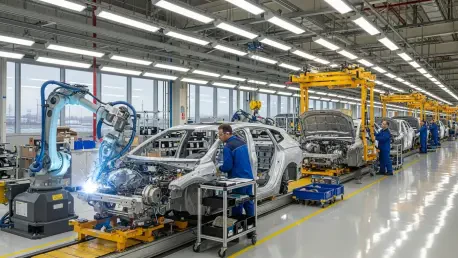The Rise of EV Manufacturing in the Southeastern U.S.
In the heart of the Southeastern United States, a transformative shift is underway as the automotive industry accelerates toward electrification, with Alabama, Georgia, and Mississippi emerging as pivotal players in this global race. This region, long known for its robust manufacturing base, is witnessing an unprecedented opportunity to redefine its legacy by embracing electric vehicle (EV) production and battery technology. The urgency to adapt to cleaner, more sustainable transportation solutions is palpable, as global demand for EVs continues to soar, positioning these states at the forefront of an industrial revolution.
Historically a powerhouse in traditional automotive production, the tri-state area reported a combined output of 1.9 million vehicles just a couple of years ago, showcasing its deep-rooted expertise and capacity. This established strength offers a solid foundation for transitioning into EV manufacturing, with the potential to become a global leader in this rapidly evolving sector. Infrastructure, workforce capabilities, and strategic location make this region uniquely suited to capture a significant share of the burgeoning EV market, setting the stage for economic expansion and technological innovation.
Central to this transformation is the Mississippi-Alabama-Georgia Network for Evolving Transportation (MAGNET), headquartered at The University of Alabama in Tuscaloosa. MAGNET represents a groundbreaking multi-stakeholder initiative, uniting government, industry, and academia to drive the region’s ambition of becoming a hub for EV and battery production. This collaborative effort is not just a response to market trends but a proactive strategy to shape the future of transportation, leveraging collective resources to ensure the Southeast remains competitive on the world stage.
MAGNET Initiative: A Collaborative Powerhouse
Uniting Government, Industry, and Academia
The MAGNET initiative stands as a testament to the power of collaboration, bringing together an impressive coalition of leaders from across three states. Governors from Alabama, Georgia, and Mississippi have joined forces with executives from Southern Company subsidiaries—namely Alabama Power, Georgia Power, and Mississippi Power—to forge a unified vision for the region’s future. Adding to this alliance are prominent university leaders from The University of Alabama, the University of Georgia, and Mississippi State University, whose academic expertise anchors the initiative in innovation and research.
This partnership has been formalized through a memorandum of understanding, a critical step that underscores the commitment of all parties to work cohesively. Further validating its potential, MAGNET has earned recognition as a semifinalist in the National Science Foundation Regional Innovation Engines competition, highlighting its promise as a model for regional economic development. Such acknowledgment from a national body emphasizes the initiative’s credibility and its capacity to influence broader industry trends.
The shared vision among these stakeholders focuses on harnessing regional strengths to foster advancements in EV technology while prioritizing workforce development and economic growth. By integrating policy support, industrial capabilities, and cutting-edge research, the collaboration aims to create a seamless ecosystem that nurtures innovation. This unique blend of perspectives ensures that the initiative is not merely reactive but strategically positioned to anticipate and address future challenges in the EV sector.
Strategic Goals and Regional Impact
At its core, MAGNET seeks to establish the tri-state area as a cornerstone of the so-called “Battery Belt,” a region poised to dominate EV battery production in the United States. The initiative’s objectives are ambitious, targeting a substantial portion of the global EV market by leveraging local manufacturing prowess and attracting significant investments. This focus on electrification is expected to catalyze job creation, with thousands of new roles anticipated in production, research, and supporting industries over the coming years.
Beyond employment, the economic benefits of MAGNET include the potential to draw billions in capital for infrastructure projects, such as advanced manufacturing facilities and energy grids tailored for EV needs. These developments promise to modernize the region’s industrial landscape, making it an attractive destination for both domestic and international companies. The ripple effects are projected to enhance local economies, improve community livelihoods, and position the Southeast as a vital contributor to national economic stability.
Looking ahead, MAGNET also aims to bolster national security by onshoring critical manufacturing capabilities, reducing dependence on foreign supply chains for EV components. This strategic move addresses vulnerabilities in global trade dynamics and ensures that the United States maintains control over essential technologies. As the initiative progresses, its impact could redefine the region’s role in safeguarding industrial independence while driving forward the electrification agenda.
Challenges in the EV Manufacturing Landscape
Navigating the path to EV dominance is not without hurdles for MAGNET and the broader Southeastern industry. Funding constraints pose a significant barrier, as substantial capital is required to build state-of-the-art facilities and support research endeavors. Additionally, coordinating efforts across state lines introduces complexities in aligning policies, resources, and timelines, which could slow down implementation if not managed effectively.
Technological and logistical challenges further complicate the landscape, particularly in scaling up production to meet global demand. Developing robust supply chains for raw materials like lithium and cobalt remains a critical concern, as does the urgent need for a skilled workforce capable of handling advanced manufacturing processes. Without targeted training programs and strategic partnerships, the region risks falling behind more established EV hubs in other parts of the world.
To address these obstacles, MAGNET is exploring public-private partnerships to secure funding and expertise, while also advocating for federal support through competitive programs like the National Science Foundation initiative. Investments in vocational training and university-led research are being prioritized to build a talent pipeline. By fostering collaboration and innovation, the initiative aims to mitigate risks and turn challenges into opportunities for growth and resilience in the EV sector.
Regulatory and Policy Environment
The regulatory framework surrounding EV manufacturing in the tri-state region plays a pivotal role in shaping its trajectory. State and federal incentives for clean energy and advanced manufacturing have created a favorable environment, offering tax breaks and grants to companies investing in electrification. These policies are designed to accelerate the adoption of sustainable practices and attract industry giants to set up operations in the Southeast.
Compliance with environmental standards and labor regulations adds another layer of complexity, requiring manufacturers to balance profitability with responsibility. Stricter emissions targets and workplace safety rules necessitate significant investments in green technologies and employee welfare programs. However, adherence to these standards can also serve as a competitive advantage, enhancing the region’s reputation as a leader in ethical and sustainable production.
MAGNET’s collaborative structure provides a unique platform to influence policy development, advocating for measures that support electrification goals. By uniting voices from government, industry, and academia, the initiative can push for tailored legislation that addresses specific regional needs, such as infrastructure funding or workforce incentives. This proactive approach to policy-making could set a precedent for how regional partnerships can drive systemic change in the automotive industry.
Future Outlook for the Tri-State EV Sector
Emerging trends in EV technology are set to shape the future of the tri-state region, with advancements in battery systems promising greater efficiency and range for electric vehicles. Innovations in solid-state batteries and recycling processes could revolutionize production, offering cost reductions and environmental benefits. Additionally, the rise of e-mobility solutions, such as shared electric fleets, signals shifting market demands that the region must adapt to in order to remain relevant.
Potential disruptors, including fierce international competition from established EV markets in Asia and Europe, pose a constant threat to regional aspirations. Evolving consumer preferences toward sustainable and autonomous transportation further complicate the landscape, requiring manufacturers to stay agile and innovative. The ability to anticipate and respond to these shifts will be crucial for maintaining a competitive edge over the long term.
MAGNET is well-positioned to navigate this dynamic environment by fostering a culture of innovation and investing in workforce skills tailored to future needs. By supporting research into cutting-edge technologies and building partnerships with global leaders, the initiative can help the Southeast carve out a niche as a hub for sustainable transportation solutions. This forward-thinking strategy ensures that the region is not just keeping pace but actively shaping the global EV market.
Conclusion: Paving the Way for Regional Prosperity
Reflecting on the journey of the MAGNET initiative, it becomes evident that this partnership marks a significant milestone in the Southeastern United States’ pursuit of economic prosperity through EV manufacturing. The collaboration among government, industry, and academia lays a strong foundation for technological advancement, demonstrating how unified efforts can transform regional ambitions into tangible outcomes.
Moving forward, stakeholders are encouraged to deepen investments in infrastructure and education to sustain momentum. Strategic federal and state support needs to be prioritized to address funding gaps, while continuous dialogue among partners is essential to refine goals and tackle emerging challenges. By maintaining this commitment, the tri-state area has the potential to solidify its standing as a leader in the electrification of transportation.
Lastly, expanding international collaborations and exploring innovative financing models offer a pathway to amplify impact. Embracing these next steps ensures that the region not only adapts to global trends but also sets new benchmarks for sustainable industrial growth, securing a prosperous legacy for future generations in Alabama, Georgia, and Mississippi.









